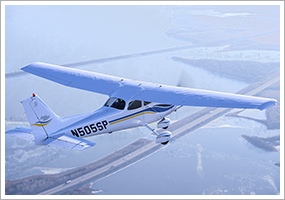| The following stories from the June 25, 2010, edition of AOPA ePilot were provided to AOPA members who expressed an interest in the particular subject areas. Any AOPA member can receive information tailored to their areas of interest by updating their preferences online. training tipsRestrictions to visibility
Why can haze be a spoiler when conditions are generally benign? “Stable air is smooth because there is little vertical movement, but this also traps haze and pollutants, so visibility can be poor in stable air,” explains the AOPA Air Safety Foundation’s “ Weather Strategies” seminar. If haze is reported, knowing the big picture can help you decide if conditions will improve or deteriorate along your route of flight, and when. For example, a stagnant high pressure area is expected to remain in place throughout the period of your flight, and haze is already affecting visibility.
What if your visibility aloft is breaking down? Flight rules specify the basic VFR weather minimums—but how can you measure that from the cockpit? Make developing the know-how a goal on any dual-instruction flight, no matter what the lesson plan for the day. “Practice estimating visibility with your flight instructor. Compare your estimates with surface reports and pilot reports,” recommended the Dec. 5, 2003, “ Training Tip: Estimating in-flight visibility.”
Remember that if conditions aloft are “interesting” to you, knowing about them will be of value to other pilots too. Make a timely pilot report (pirep). Your fellow aviators will really appreciate it, and making a pirep provides a valuable experience working with the flight service system. “All pilots should know how to make pireps and should ask for reports during preflight briefings. You should also ask for updated weather reports, including those from pilots, during flights,” wrote Jack Williams in “ Pirep plea,” in the January 2003 issue of Flight Training. Don’t know how to make a pirep? Try the AOPA Air Safety Foundation course Skyspotter: Pireps made easy .
Another tip on visibility: Because an opaque atmosphere conceals obstructions, embedded thunderstorms, and other hazards, treat any reported visibility restriction as not just an inconvenience, but as the serious weather phenomenon it is! training productsKing Schools iPhone coursesKing Schools is now offering five of its many training courses for the iPhone. With topics such as takeoffs and landings and communication, the iPhone application allows users to watch on the go. The iPhone applications complement the company’s 60 online courses. Note: Products listed have not been evaluated by ePilot editors unless otherwise noted. AOPA assumes no responsibility for products or services listed or for claims or actions by manufacturers or vendors. final examQuestion: What does “cleared for the option” mean at a towered airport?
Answer: When air traffic control authorizes the “cleared for the option” procedure, the aircraft is permitted to make a low approach; missed approach; or touch-and-go, stop-and-go, or full-stop landing. As a training aid, it enables an instructor or examiner to observe the reaction of a student or applicant under changing conditions. If you would like to utilize the flexibility this procedure provides, make your request before passing the final approach fix on an instrument approach or while downwind in the pattern. This procedure is only used at locations with an operational control tower and is subject to ATC approval. For answers to other questions involving air traffic control, see the AOPA Air Safety Foundation’s Web page, Ask ATC.
Got a question for our technical services staff? E-mail [email protected] or call the Pilot Information Center, 800/872-2672. Don’t forget the online archive of “Final Exam” questions and answers, searchable by keyword or topic. |
 The June 18 “
The June 18 “ 

